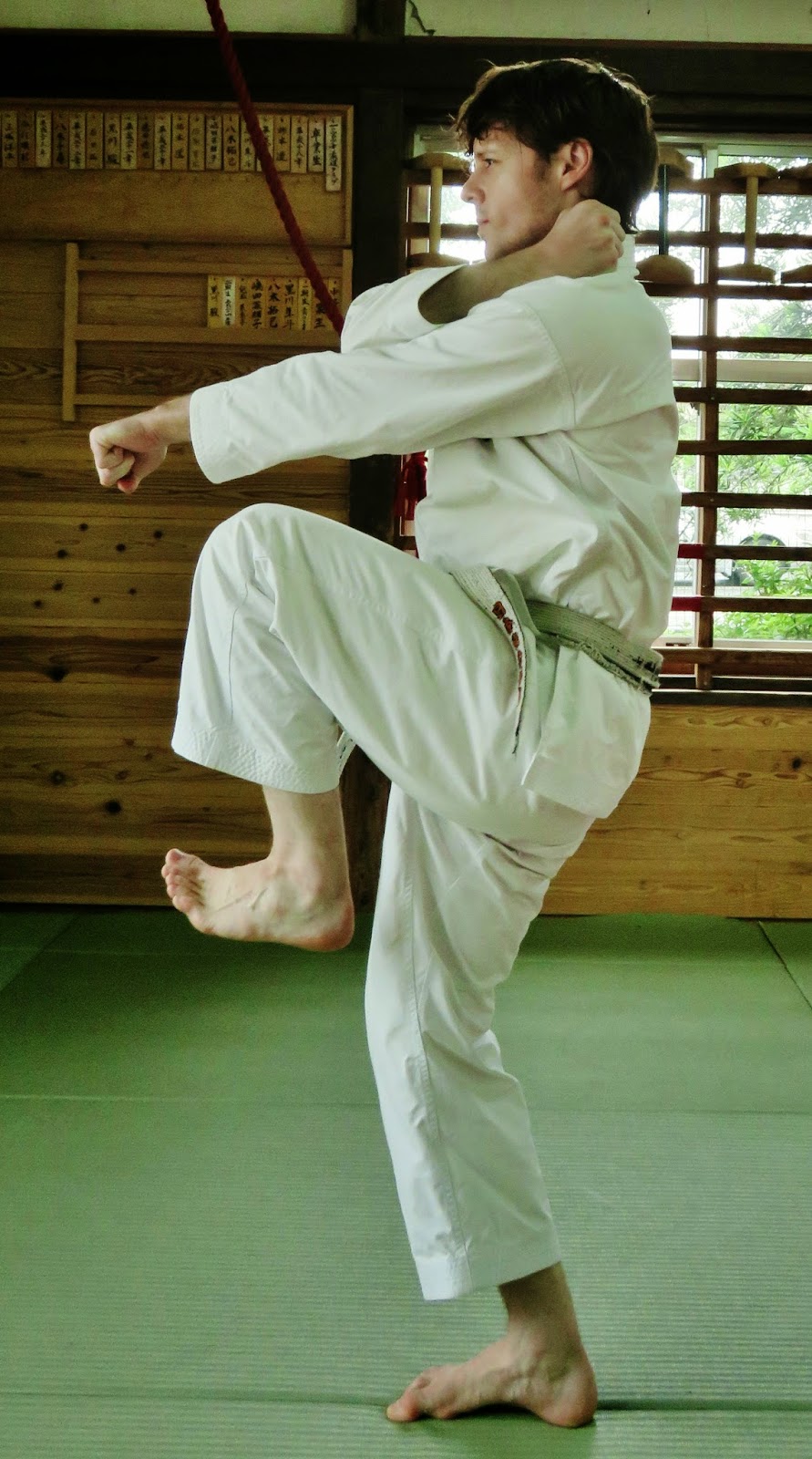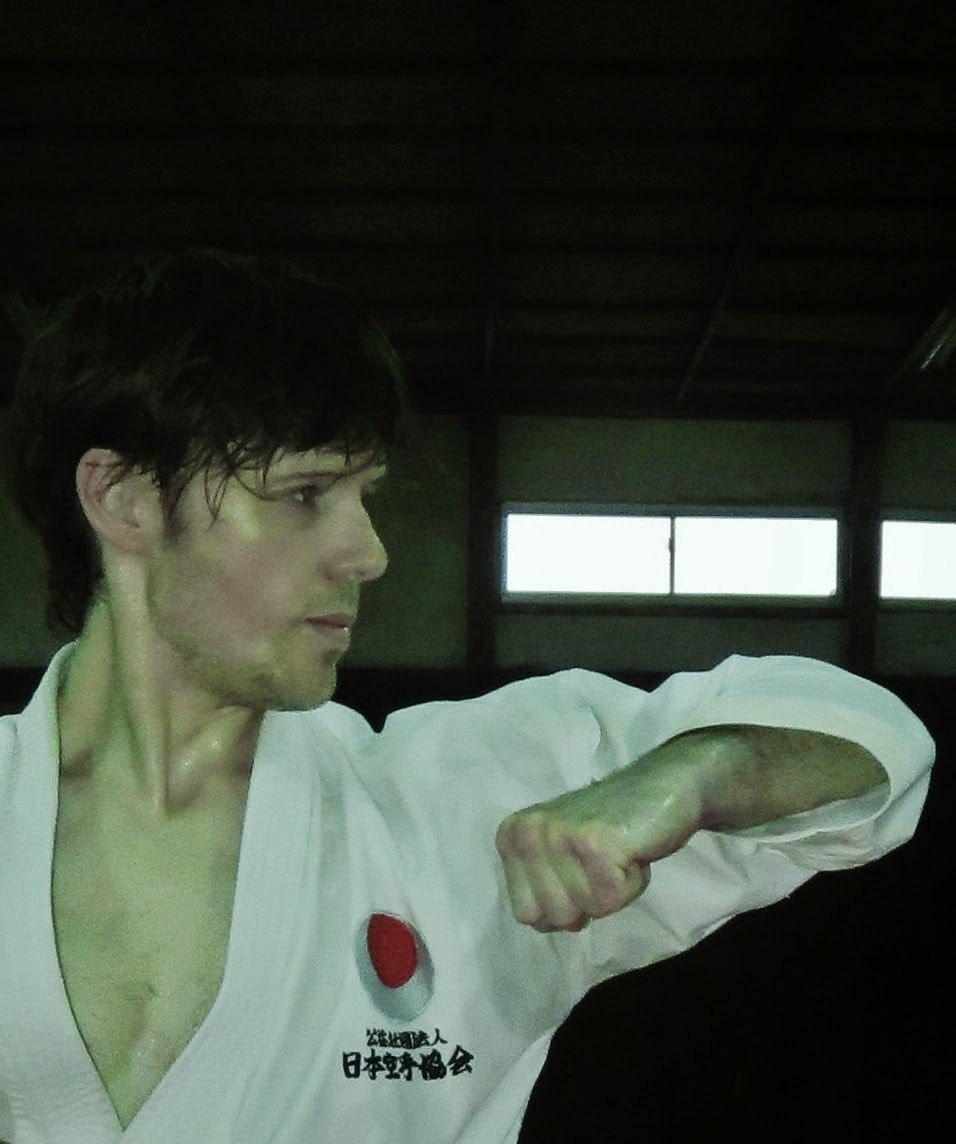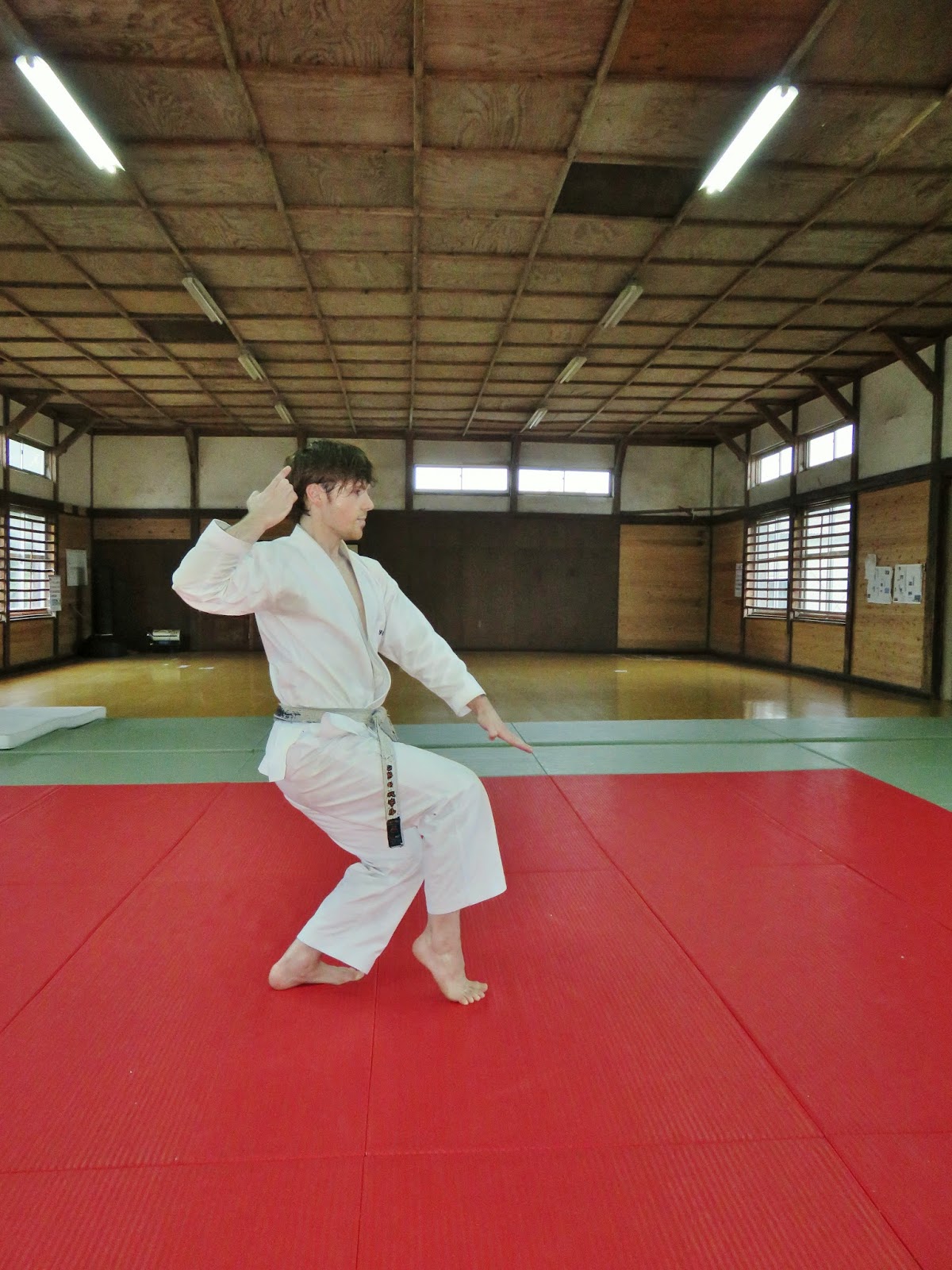 |
| Practicing in a confined space after dojo training: one of my methods to specifically "review". |
Here is a general outline of my
tokui-gata, Gojushiho Dai (五十四歩大). As you will know, Gojushiho Dai literally translates
as `54 steps major’. The number 54 comes from Buddhism as it has special
relevance, just as Suparinpei (Hyakuhachiho / Hyakuhappo) `108 steps’ does.
With this in mind, there are two main reasons why Shotokan-ryu has two forms of
`Gojushiho’ (Gojushihodai and Gojushihosho); these are: (a) to form ‘108’
pertaining to the aforementioned point; and (b) “…to physically balance
training on the legs”—Gojushiho Dai loads the left leg (with migi ashi mae
neko-ashi dachi) and Gojushihosho the loads right leg (with migi
kokutsu-dachi). Lastly, but not least, I hope this outline of Gojushiho Dai
helps you with your practice of it. As the longest kata amongst the 25 “official”
JKA formal exercises, it is an extreme challenge—irrespective of one’s
technical level. For more information on Gojushiho Dai please check out my
recent article on it: http://andrebertel.blogspot.jp/2014/06/gojushiho-dai.html. I'd like to conclude that I am not a Buddhist, however, we must consider the historical/sociological contexts, which have influenced the development of karate-do. Best wishes, André Bertel.
 |
| Karatedo Kata (Vol.4): This four book series is the current "BIBLE" of Shotokan Karate-Do Kata. |
REI: (Musubi dachi).
YOI: (Hachiji-dachi).
1. Migi uraken Jodan tatemawashi uchi doji ni
hidari zenwan munemae suihei kamae (Migi zenkutsu dachi).
2. Ryo ken chudan morote uke (Hidari zenkutsu
dachi).
3. Ryo ken chudan morote uke (Migi zenkutsu
dachi).
4. Hidari tateshuto chudan uke (Hidari zenkutsu
dachi).
5. Migi chudan gyaku zuki (Hidari zenkutsu
dachi).
6. Hidari chudan maete zuki (Hidari zenkutsu
dachi).
7. Migi chudan mae keage (Hidari ashi dachi).
8. Migi chudan gyaku zuki (Hidari zenkutsu
dachi).
9. Migi tateshuto chudan uke (Migi zenkutsu
dachi).
10. Hidari chudan gyaku zuki (Migi zenkutsu
dachi).
11. Migi chudan maete zuki (Migi zenkutsu dachi).
12. Hidari chudan mae keage (Migi ashi dachi).
13. Hidari chudan gyaku zuki (Migi zenkutsu
dachi).
14. Migi jodan tate enpi uchi (Migi zenkutsu
dachi),
15. Sasho gedan sukui uke doji ni usho koko gedan
osae (Hidari zenkutsu dachi).
16. Migi keito chudan uke doji ni hidari teko migi
hiji shita (Migi ashi mae neko ashi dachi).
17. Hidari shuto gedan uke doji ni migi keito
kamae (Migi mae ashi neko ashi dachi).
18. Migi chudan ippon nukite otoshi zuki doji ni
sasho migi hiji uchigawa (Yori ashi: migi mae ashi neko ashi dachi).
19. Hidari chudan ippon nukite otoshi zuki doji ni
sasho hidari hiji uchigawa (Migi mae ashi neko ashi dachi).
20. Migi chudan ippon nukite otoshi zuki doji ni
sasho migi hiji uchigawa (Migi mae ashi neko ashi dachi).
21. Migi keito chudan uke doji ni hidari teko migi
hiji shita (Migi ashi mae neko ashi dachi).
22. Hidari shuto gedan uke doji ni migi keito
kamae (Migi mae ashi neko ashi dachi).
23. Migi chudan ippon nukite otoshi zuki doji ni
sasho migi hiji uchigawa (Yori ashi: migi mae ashi neko ashi dachi).
24. Hidari chudan ippon nukite otoshi zuki doji ni
sasho hidari hiji uchigawa (Migi mae ashi neko ashi dachi).
25. Migi chudan ippon nukite otoshi zuki doji ni
sasho migi hiji uchigawa (Migi mae ashi neko ashi dachi).
26. Hidari haito hidari sokumen gedan uke doji ni
migi shuto suigetsumae kamae (Kiba dachi).
27. (Migi ashi mae kosa).
28. Ryo sho migi sokumen jodan bo tsukami uke
(Kiba dachi).
29. Migi haito migi sokumen gedan uke doji ni
hidari shuto suigetsumae kamae (Kiba dachi).
30. (Hidari ashi mae kosa).
31. Ryo sho hidari sokumen jodan bo tsukami uke
(Kiba dachi).
32. Migi keito chudan uke doji ni hidari teko migi
hiji shita (Migi ashi mae neko ashi dachi).
34. Migi chudan ippon nukite otoshi zuki doji ni
sasho migi hiji uchigawa (Yori ashi: migi mae ashi neko ashi dachi).
35. Hidari chudan ippon nukite otoshi zuki doji ni
sasho hidari hiji uchigawa (Migi mae ashi neko ashi dachi).
36. Migi chudan ippon nukite otoshi zuki doji ni
sasho migi hiji uchigawa (Migi mae ashi neko ashi dachi).
37. Migi gedan shihon yoko nukite (Hidari
zenkutsu-dachi).
38. Migi uraken tatemawashi uchi (Migi
zenkutsu-dachi).
39. Hidari gedan shihon yoko nukite (Migi zenkutsu
dachi)
40. Hidari uraken tatemawashi uchi (Hidari
zenkutsu-dachi).
41. Migi gedan washide gedan otoshi uchi (Migi
zenkutsu dachi).
42. Migi jodan washide tsukiage (Migi zenkutsu
dachi).
43. Hidari jodan mae keage (Migi ashi dachi).
44. Saken chudan zuki doji ni uken hidarikata
maeue (Migi ashi dachi).
45. Hidari Jodan yoko enpi doji ni uken koho gedan
uke (Hidari hizakutsu).
46. Migi keito chudan uke doji ni hidari teko migi
hiji shita (Migi ashi mae neko ashi dachi).
47. Hidari shuto gedan uke doji ni migi keito
kamae (Migi mae ashi neko ashi dachi).
48. Migi chudan ippon nukite otoshi zuki doji ni
sasho migi hiji uchigawa (Yori ashi: migi mae ashi neko ashi dachi).
49. Hidari chudan ippon nukite otoshi zuki doji ni
sasho hidari hiji uchigawa (Migi mae ashi neko ashi dachi).
50. Migi chudan ippon nukite otoshi zuki doji ni
sasho migi hiji uchigawa (Migi mae ashi neko ashi dachi).
51. Hidari haito hidari sokumen gedan uke doji ni
migi shuto suigetsumae kamae (Kiba dachi).
53. Hidari tateshuto chudan uke kara migi chudan
tateshihon nukite doji ni hidari hiji yokohari saken hidari koshi (Migi ashi
dachi kara kiba dachi).
54. Migi haito migi sokumen gedan uke doji ni
hidari shuto suigetsumae kamae (Kiba dachi).
55. (Hidari ashi mae kosa).
56. Hidari tateshuto chudan uke kara migi chudan
tateshihon nukite doji ni hidari hiji yokohari saken hidari koshi (Migi ashi
dachi kara kiba dachi).
58. Hidari kentsui chudan uchimawashi uchi (Kiba
dachi).
59. Migi chudan jun zuki (Migi zenkutsu dachi). – Kiai
60. Ryo hiji suihei ryoken ryochichi shita (Hachiji
dachi).
61. Ryo kentsui koho chudan hasami uchi (Hachiji
dachi).
62. Ryo hiji suihei ryoken ryochichi shita
(Hachiji dachi).
63. (Hidari zenkutsu dachi).
64. Ryote ryogawa gedan kakiwake (Migi ashi mae
nekoashi dachi).
65. Ryo keito haneage uke (Migi ashi mae nekoashi
dachi).
66. Morote chudan ippon nukite otoshi zuki (Yori
ashi: migi ashi mae nekoashi dachi).
67. Migi keito chudan uke doji ni hidari teko migi
hiji shita (Migi ashi mae neko ashi dachi).
© André Bertel.
Aso-shi, Kumamoto-ken. Japan (2014).
















